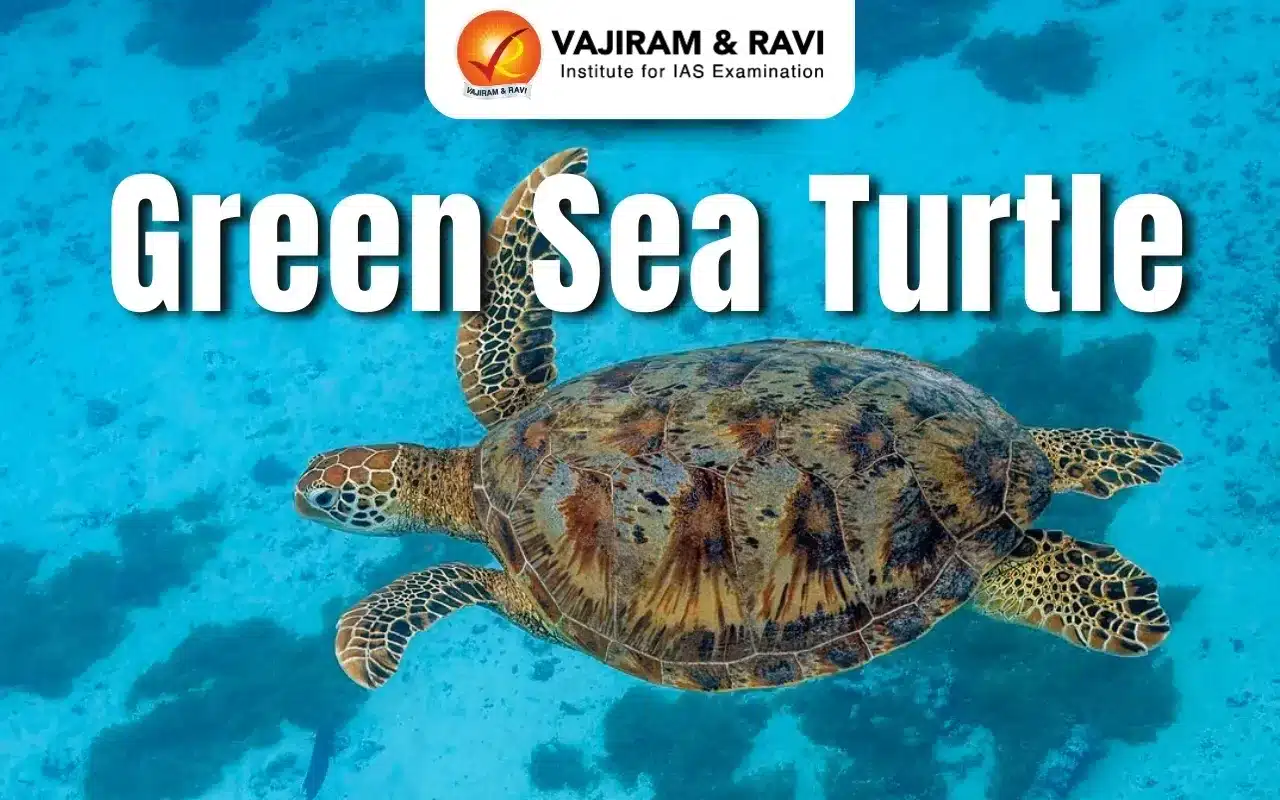Green Sea Turtle Latest News
The carcass of a green sea turtle washed ashore on Marina beach in Chennai recently.
About Green Sea Turtle
- It is the largest hard-shelled sea turtle.
- Scientific Name: Chelonia mydas
- They are unique among sea turtles in that they are herbivores, eating mostly seagrasses and algae.
- This diet is what gives their fat a greenish color (not their shells), which is where their name comes from.
Green Sea Turtle Distribution
- Green turtles are found throughout the world, mainly in tropical and subtropical waters.
- These turtles are found nesting along the coastline of more than 80 countries, with the largest nesting populations found in Costa Rica and Australia.
- Similar to other sea turtles, green sea turtles migrate long distances between their feeding grounds and their nesting sites, with recorded distances longer than 1,615 miles (2,600 kilometers).
Green Sea Turtle Features
- They are large in size, attaining about 120 cm in length and weighing about 136-159 kg.
- They have a comparatively small head.
- The green turtle has a smooth carapace which varies in shape, between sub-circular and heart-shaped, and in colouration between black, grey, green, brown, and yellow. The plastron (bottom shell) is yellowish-white in colour.
- They do not have teeth, but their jaws have modified “beaks” suited to their particular diet.
- They do not have visible ears but have eardrums covered by skin. They hear best at low frequencies, and their sense of smell is excellent.
- Their vision underwater is good, but they are nearsighted out of water.
- Their streamlined bodies and large flippers make them remarkably adapted to life at sea.
- Lifespan: Estimated to be 60-70 years.
Green Sea Turtle Conservation Status
It is classified as ‘Endangered’ under the IUCN Red List.
Green Sea Turtle FAQs
Q1. Where are green turtles found in India?
Ans. It occurs in the west and east coasts of India, Lakshadweep and Andaman & Nicobar Islands.
Q2. Why are green turtles so important?
Ans. Green turtles graze on seagrasses and algae, which maintains the seagrass beds and makes them more productive.
Q3. What is the IUCN status of the green turtle?
Ans. Endangered
Source: TH
Last updated on June, 2025
→ UPSC Notification 2025 was released on 22nd January 2025.
→ UPSC Prelims Result 2025 is out now for the CSE held on 25 May 2025.
→ UPSC Prelims Question Paper 2025 and Unofficial Prelims Answer Key 2025 are available now.
→ UPSC Calendar 2026 is released on 15th May, 2025.
→ The UPSC Vacancy 2025 were released 1129, out of which 979 were for UPSC CSE and remaining 150 are for UPSC IFoS.
→ UPSC Mains 2025 will be conducted on 22nd August 2025.
→ UPSC Prelims 2026 will be conducted on 24th May, 2026 & UPSC Mains 2026 will be conducted on 21st August 2026.
→ The UPSC Selection Process is of 3 stages-Prelims, Mains and Interview.
→ UPSC Result 2024 is released with latest UPSC Marksheet 2024. Check Now!
→ UPSC Toppers List 2024 is released now. Shakti Dubey is UPSC AIR 1 2024 Topper.
→ Also check Best IAS Coaching in Delhi
























